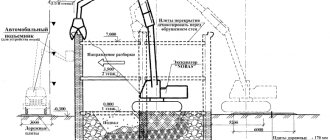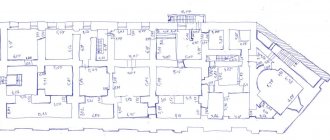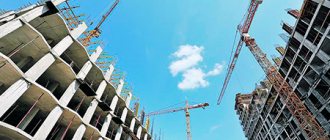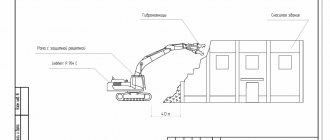If, during an assessment of the technical condition of a building, it was discovered that its operational performance and characteristics have been reduced by more than 50%, the facility is recognized as emergency. This category is assigned to structures with such damage and defects that at any moment can cause the collapse of a wall, foundation, or roof.
An examination of an emergency building helps to develop a list of urgent emergency measures. They usually involve the complete replacement of structural elements that pose a danger to humans. Other possible emergency measures are unloading the building, significantly reducing the intensity of its operation, installing temporary racks, fastenings and fences indicating the unsafety of the site. An examination is also carried out to obtain an objective assessment and the real technical condition of the building.
Signs and causes of building failure
The main sign of the emergency condition of a residential building is that more than half of the premises and load-bearing structural elements (foundation and walls) in it pose a danger to human life. They have such deformations and damage that at any moment can provoke the collapse or overturning of the building. For example, settlement of the foundation, partial or complete destruction of internal partitions and roofing, deep cracks on the facade of the building.
Sometimes an expert can identify signs of a building being in disrepair only during detailed instrumental studies, and in some cases, a visual inspection and measurement work is sufficient for this.
The emergency condition of the building indicates that the load-bearing structural elements have exhausted their operational capabilities and do not meet the requirements of reliability, stability and strength.
Examples of damage - potential causes of accidents
An emergency condition can arise due to various factors: climatic, mechanical, temporary. During the operation of a building, various damages accumulate in the structure. If they are not identified and eliminated in a timely manner, they will progress, and sooner or later there will be a real threat of partial or complete collapse of the structure. Examples of such damage:
- corrosion of metal elements;
- aging and fatigue of materials;
- wood rotting;
- defrosting concrete and masonry;
- mechanical deformations resulting from production activities and vehicles;
- slow change in soil conditions on the site where the building is built;
- corrosive effects of groundwater, changes in their level;
- creep and heaving of soil due to freezing.
The speed at which damage progresses depends on the intensity of use, the availability of regular maintenance, and exposure to aggressive environmental factors.
Other causes of accidents
Sometimes the reason for the sudden collapse of a building is serious mistakes made at the design and construction stage. It could be an unsuccessfully developed project, low-quality building materials, or an unscrupulous approach by the contractor to installation work.
The main gross design and construction errors that cause building collapses are:
- the actual intensity of operation of the building exceeded the calculated predicted values;
- During geotechnical surveys, an insufficient number of wells were completed;
- all geological conditions at the construction site were taken into account incorrectly or not;
- not all external influences and loads are provided for;
- new solutions were used that have not undergone preliminary testing and evaluation;
- human error: the designer had little time or experience to competently develop the documentation.
The listed errors can cause the building to collapse in the first year of operation.
The procedure for recognizing a non-residential building as unsafe
In order to recognize a non-residential premises, for example, a school building, as unsafe, the following procedure must be followed:
- Create an interdepartmental commission.
- Conduct an inspection of the premises.
- Issue a conclusion from the commission body.
- Carry out demolition of the premises.
- Remove the building from registration in the Unified State Register.
In the case of complex development of the territory, the local government body is obliged to draw up a list of non-residential buildings that are subject to demolition. The basis for dismantling a structure is the presence of conditions for recognizing it as emergency.
To be included in the list of premises that are subject to subsequent assessment, there must be visual damage to the capital construction project.
Important! The building must be located on the territory of this local government body.
The responsibility for conducting a visual inspection and subsequent engineering examination rests with a specialized organization. The institution must have a license to conduct this type of activity.
Powers are transferred to the organization on the basis of an agreement concluded with the district administration. The company is selected on the basis of a competition carried out under a contract system in the field of procurement of services and goods.
The subject of the agreement is:
- actual assessment of the condition of the capital construction project;
- assessment of the condition of its individual elements;
- assessment of design quality indicators;
- analysis of the state of the territory on which the object is located;
- presence/absence of impact on the building of anthropogenic and natural factors.
The conclusion of a specialized organization should allow one to conclude that demolition of the premises is necessary or there is no need for dismantling.
Creation of an interdepartmental commission
The commission is created by a decision of the local administration if the need arises for the integrated development of the territory.
| No. | Bodies whose representatives should be members of the commission |
| 1 | Fire safety |
| 2 | Environmental and sanitary safety |
| 3 | Bureau of Technical Inventory |
| 4 | Specialists authorized to prepare an expert opinion on project documentation |
| 5 | Administration officials from the architecture department |
The owners of the premises and other rights holders are included in the commission with the right to an advisory vote.
Within 10 days from the date of the decision on the creation of an interdepartmental commission, representatives of the administration are obliged to notify all interested parties about this.
These bodies are required to submit a list of candidates to the commission within 7 days from the date of notification.
Within 7 days from the receipt of information, the local government body forms the composition of the commission. This information is sent to the authorized bodies no later than 10 days after the first meeting.
Inspection of the emergency room
The procedure for inspecting non-residential premises, which must be recognized as unsafe, must include the following steps:
- Studying the application to recognize the facility as unsafe and the relevant documentation.
- Assessment of the actual condition of the premises.
- Conducting specialized examination.
- Drawing up a conclusion about the actual condition of the object.
- Making a decision to recognize an object as unsafe.
- Notification of owners and copyright holders about the demolition of premises.
The law places the responsibility for making a decision on recognizing an object as unsafe on the body that is the owner of the non-residential premises. Thus, it is the local government body. With the exception of objects owned by a constituent entity of the Russian Federation or the state.
Conclusion of the interdepartmental commission
The form of the document is regulated by Government Decree No. 577 of 2017.
The conclusion on the actual assessment of the condition of the premises should include:
- Title of the document;
- Address of the object;
- document number, date of creation of the conclusion;
- details of the document on the creation of the commission;
- Chairman's details;
- list of members;
- list of experts for design documentation and engineering survey results;
- list of owners and other rights holders;
- data from the specialized organization that issued an opinion on the condition of the object;
- list of materials and results of instrumental studies;
- the decision that has been made;
- annex to the conclusion;
- signatures of the chairman and members of the commission.
The following is indicated as an appendix to the conclusion of the interdepartmental commission:
- materials and results of instrumental studies;
- conclusion of engineering examination;
- special opinion of the interdepartmental commission.
Sample form for conclusion of an interdepartmental commission
Inspection of buildings for accidents in Moscow
An examination of a dangerous building will help owners of residential premises defend their rights in court. Experts conduct an assessment in several stages:
- Study of design and technical documentation, layouts, geological surveys and other information about the facility. At the first stage, the expert analyzes any information that will help him find out the level of operational performance of the building and develop an action plan.
- Visual and instrumental examination of the object, measurement work. The purpose of the second stage is to obtain objective information about the technical condition of the structure. Sometimes a visual inspection is sufficient to recognize or confirm an accident. For visual and instrumental research, specialists choose methods that are safe for the expert’s life. For example, a photogrammetric method of measuring work, which allows you to remotely examine an emergency building.
- Processing the information received, preparing an expert report. In conclusion, the specialist indicates the actual data about the object, compares them with regulatory requirements, and records the detected defects. The information obtained serves as the basis for recognizing the object as emergency or operational.
offers legal entities and individuals inspection of residential and non-residential buildings for accident rates in Moscow. Qualified specialists will complete the entire range of work as quickly as possible and draw up an expert report, which you can present in court if necessary. You can request a commercial offer or a free consultation using the form on the website.
Cases of building collapses in foreign countries in 2011-2013
Construction was carried out without appropriate permission from the authorities and without observing safety measures. The deputy head of the administration of the local municipality, several other officials, a constable of one of the police stations, as well as the organizers of the construction were arrested. The investigation received documents confirming the facts of bribe payments during the construction of the building.
On January 16, an eight-story residential building collapsed in one of the densely populated areas of Alexandria Maamura, Egypt. Rescuers recovered 25 bodies from the rubble. The number of wounded people found in the ruins of the building was 15 people. As the governor of Alexandria stated, the construction of the building was carried out without the necessary documents; in particular, the municipal authorities did not issue a construction license to the developer.
2012
On the night of December 18 in Palermo, Italy, three people were killed, another was missing and seven were injured as a result of the collapse of two residential buildings.
On November 7, in the capital of Ghana, Accra, a six-story building of a shopping center collapsed 15 minutes before opening, containing mainly employees of the stores located there. During search and rescue operations, 67 people were rescued from the rubble. Nine people died.
On July 22 , it became known that six people died in Beijing when houses collapsed as a result of heavy rain.
On July 14, an uninhabited emergency eleven-story building collapsed on four nearby low-rise residential buildings in the west of Alexandria, Egypt. 15 people died. Five people were pulled out alive from the rubble.
On June 10, a five-story residential building collapsed in Lutsk (Ukraine) - load-bearing structures from the first to fifth floors between the first and second entrances collapsed. Rescuers brought 18 people out of the building. As a result of the tragedy, two people were killed and one was injured.
On April 15, a residential building collapsed in eastern China's Fujian province. At least nine people were killed and 55 were injured. The collapse of the house was caused by an explosion in a nearby garage. The cause of the explosion has not been established.
On April 7, a Catholic church building collapsed as a result of heavy rain in Benue State in eastern Nigeria. The elements tore off the roof, then the walls of the church collapsed. 22 people were killed, 31 people were injured.
On February 1, a three-story building collapsed in the city of Dumyat in northern Egypt. The building housed the office of the Egyptian Al-Wasat party. The cause of the accident was repair work, which affected the load-bearing structures of the building. Seven people were killed and 28 were injured.
On January 25, two multi-story buildings and a four-story house collapsed in Rio de Janeiro, Brazil. Rescuers found 17 bodies.
On the night of January 18, in the center of Havana (Cuba), part of a three-story residential building collapsed, killing four people and injuring four more.
On January 15, a five-story residential building collapsed in Beirut, Lebanon. The cause of the collapse was cracks in an old building caused by heavy rains. 27 people were killed, 12 were injured.
2011
On October 3, a three-story building collapsed in the center of the southern Italian city of Barletta. The dilapidated building housed a sewing workshop. The house, which was in disrepair, collapsed due to construction work taking place next door. Three women and a 14-year-old girl died.
On August 4, a five-story residential building collapsed in the Pakistani port city of Karachi. 29 people died.
On August 4, a house collapsed in the Chinese village of Shantuhu, Zhangshu City, Jiangxi Province. One of the walls of the building collapsed while a group of villagers were resting near it in the shade. Ten people were killed and two were injured.
On June 26, a five-story building collapsed during work to add an additional floor in the city of Xi'an, Shaanxi Province, northwestern China. The cause of the tragedy was illegal construction in violation of safety rules. Seven people died.
On February 11, a seven-story residential building collapsed in the Egyptian city of Luxor in the south of the country. The building was in disrepair. 15 people were killed, 20 were injured.
The material was prepared based on information from open sources











